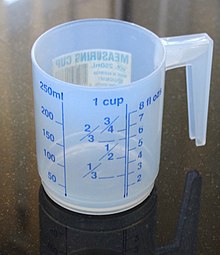Plastic cup


A plastic cup is a cup made out of plastic. It is most commonly used as a container to hold beverages. Some are reusable while others are intended for a single use followed by recycling or disposal. Some are see through, while others are not.
Distinguishing features
Plastic cups come in a variety of colours, textures and sizes.
Uses

Plastic cups are often used for gatherings where it would be inconvenient to wash dishes afterward, due to factors such as location or number of guests. Plastic cups can be used for storing most liquids, but hot liquids may melt or warp the material.
Environmental issues
Most plastic cups are designed for single uses and then disposal or recycling.[1] A life cycle inventory of a comparison of paper and plastic shows environmental effects of both with no clear winner.[2]
Production of 1 tonne (0.98 long tons; 1.1 short tons) of plastic cup emits 135 pounds (61 kg) of green house gases.
The choice between paper cups and plastic cups has to do with the life of the item after use. A paper cup may biodegrade faster than a Styrofoam cup or a plastic cup. In general cardboard or paper takes one to three months for biodegradation, as the majority of the content, up to 95%, is made with wood chips. A plastic cup can take up to 90 years to biodegrade, depending on the type of plastic.
Plastic cups are made with oil, which is not a renewable source. On the other hand, paper cups can be sourced from forests which fall under sustainable management.
Plastic cups, especially those made with polystyrene, are also a possible health hazard as chemicals may leach into the beverage. This is more likely to happen with warm drinks (hot chocolate, tea and coffee) than with cold drinks.[3]
See also
- Coffee cup
- Cup drink
- Cup holder
- Paper cup
- Polylactic acid (used in making decomposable plastic cups)
- Pythagorean cup
References
- ^ Schnurr, Riley E.J.; Alboiu, Vanessa; Chaudhary, Meenakshi; Corbett, Roan A.; Quanz, Meaghan E.; Sankar, Karthikeshwar; Srain, Harveer S.; Thavarajah, Venukasan; Xanthos, Dirk; Walker, Tony R. (2018). "Reducing marine pollution from single-use plastics (SUPs): A review". Marine Pollution Bulletin. 137: 157–171. doi:10.1016/j.marpolbul.2018.10.001. PMID 30503422.
- ^ Hocking, M. B. (1991). "Paper Versus Polystyrene: A Complex Choice". Science. 251 (4993): 504–505. doi:10.1126/science.251.4993.504. PMID 17840849.
- ^ Dvorsky, George (March 28, 2013). "How To Recognize the Plastics That Are Hazardous To Your Health". Retrieved January 29, 2016.
